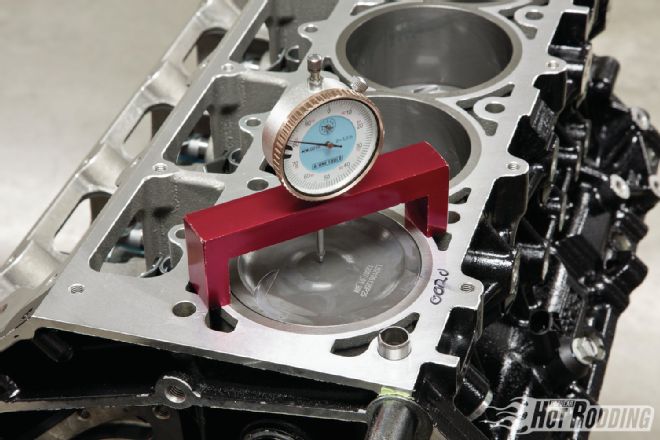
Son, you better get yourself some tubs. It's not often that you open up an engine build story by talking about chassis modifications, but with the way Mast Motorsport's supercharged 427ci LS small-block goes about delivering its 917 hp, seriously fat tires and a well-sorted suspension are an absolute must. Before we delve into the specs, we suggest hopping in your car and cinching down that five-point harness. At 6,200 rpm, a stock 427ci LS7 produces 505 hp. In comparison, at that same rpm the Mast LS3-based 427 kicks out a staggering 907 hp. That equates to an 80 percent advantage in power, and the only way to accomplish that given a similar displacement and rpm range is by making 80 percent more torque. The supercharged Mast 427 comes pretty darn close to doing just that, straining the dyno with 817 lb-ft compared to a stock LS7's 475 lb-ft. At the risk of sounding redundant, son, you better get yourself some tubs.
As impressive as the peak horsepower and torque figures may be, what's even more shocking is how much of that output is on tap throughout the entire rpm range. At just 3,100 rpm, the Mast 427 is already producing 743 lb-ft of torque, which equates to 91 percent of its peak output. That's enough to trounce a healthy street/strip big-block. For example, the 532ci big-block Ford in PHR's now-retired Fox Mustang project car—a combo that peaked at 775 hp—was good for just 546 lb-ft at 3,500 rpm and 673 lb-ft at its torque peak. Furthermore, the Mast 427 averages 789 lb-ft between its 3,100- to 6,400-rpm operating range, whereas PHR's big-block Ford mustered a measly 607 lb-ft average torque output. That's the kind of torque that renders half the gears in a six-speed transmission irrelevant, and makes dealing with the size and weight penalty of a big-block a highly questionable proposition.
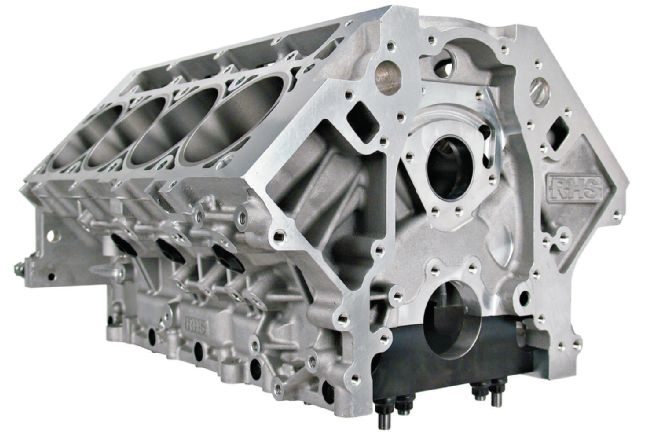 Designing an aluminum block that weighs within an eyelash of stock LS7 block, yet can handle 2,500 hp, is a truly remarkable feat. The RHS LS Race Block features an intricate web of strategically placed reinforcement webs. Similarly, the block uses a refined water jacket design for consistent cylinder wall thickness and maximum cylinder liner support. The bulkheads and inner bore sections are chilled during the manufacturing process to optimize the metallurgical properties of the block.
Designing an aluminum block that weighs within an eyelash of stock LS7 block, yet can handle 2,500 hp, is a truly remarkable feat. The RHS LS Race Block features an intricate web of strategically placed reinforcement webs. Similarly, the block uses a refined water jacket design for consistent cylinder wall thickness and maximum cylinder liner support. The bulkheads and inner bore sections are chilled during the manufacturing process to optimize the metallurgical properties of the block.
Make no mistake, this isn't some unstreetable one-trick pony. Mast Motorsports' design philosophy is all about achieving OE levels of driveability and reliability in addition to maximizing power output. Street cars don't run on Q16, so by keeping the compression ratio reasonable and using Mast's own cutting-edge 12-degree LS3 cylinder heads, the supercharged 427 makes its 917 hp on 93-octane pump gas. For a smooth idle quality and street-friendly low-rpm driveability, the engine's 234/254-at-.050 hydraulic roller cam is relatively mild given its commodious displacement volume. Likewise, the reasonable cam duration maxes out the power curve at a moderate 6,400 rpm, minimizing stress on the valvetrain and enhancing durability. So while the supercharged Mast 427 might run like a race motor, it's perfectly suited for a street car—make that a very fast street car. The best news is that anyone can call up Mast Motorsports and order this exact engine combo as a turnkey crate motor.
Big Power, Small Package
Many of today's engine builders report that compared to years past, fewer and fewer hot rodders are opting to build big-blocks. Considering the tremendous power potential offered by modern small-blocks like the LS-series platform, this trend makes a lot of sense, especially in Pro Touring machines where removing weight off the nose of the car substantially improves handling. Not only do aftermarket LS blocks allow for displacement exceeding 500 cubes, there's no shortage of aftermarket heads that can keep pace. Throw a 2.9L Whipple supercharger into the mix, and the result is an insane amount of power in a package not much larger than a wimpy German straight-six. As no surprise, the supercharged Mast 427 takes advantage of the latest in aftermarket block, cylinder head, and power adder technology.
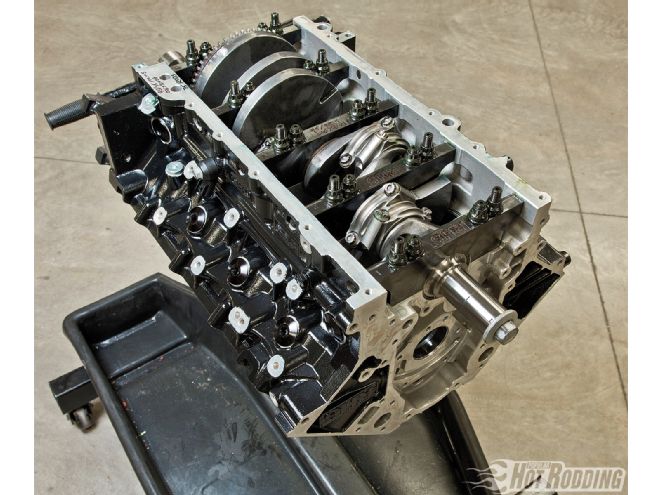 The crankcase on the RHS block comes preclearanced to accommodate strokes up to 4.500 inches. As such, the Callies 4.000-inch forged steel crank used in the Mast 427 cleared with room to spare. While Mast typically sets main bearing clearances at .0023 to .0025 inch on its naturally aspirated motors, it opens them up to .0025 to .0027 inch in its supercharged combos to better handle the increased loads generated by forced induction.
The crankcase on the RHS block comes preclearanced to accommodate strokes up to 4.500 inches. As such, the Callies 4.000-inch forged steel crank used in the Mast 427 cleared with room to spare. While Mast typically sets main bearing clearances at .0023 to .0025 inch on its naturally aspirated motors, it opens them up to .0025 to .0027 inch in its supercharged combos to better handle the increased loads generated by forced induction.
Every motor needs a solid foundation to hold everything together, and this is particularly true when horsepower figures start approaching quadruple-digit territory. Iron is usually the material of choice for engine blocks at this power level, as the distortion associated with aluminum blocks can lead to compromised ring seal and reduced power output. Fortunately, thanks to RHS's LS engine block, fans of the GM Gen III/IV platform can enjoy the durability of an iron block in a lightweight aluminum package. The rugged RHS unit is cast from A357-T6 aluminum, and has proven reliable in 2,000-plus horsepower forced induction combinations. Nonetheless, at 119 pounds it weighs just a hair more than a production LS7 block. For these reasons, it was the block of choice for Mast's blown 427. Mast also builds motors based on the virtually indestructible Chevrolet Performance LSX block with great results, but for this particular build, the nod went to the lighter RHS unit.
A durable rotating assembly is essential to the longevity of any supercharged engine combination, but the parts don't need to be as exotic as you might expect. The beauty of a forced-induction motor is that while they subject the rotating assembly to severe compressive loads, tensile (stretching) loads—which are far more detrimental—are kept in check by keeping peak rpm at a reasonable level. That means that even at over 900 hp, the off-the-shelf Compstar 4.000-inch forged 4340 steel crank and 6.125-inch connecting rods used in the Mast 427 are more than up to the challenge. Billet components would simply be pricey overkill. The same logic applies to the off-the-shelf Mahle 9.45:1 pistons, which are forged from a 2618 alloy aluminum and feature a -25cc dish.
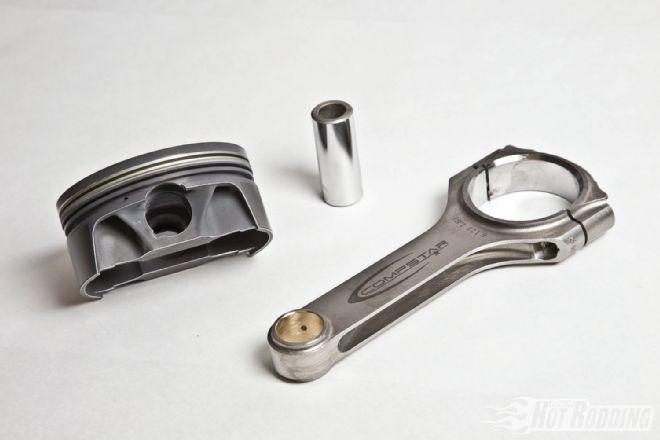 With peak power arriving at a modest 6,400 rpm, off-the-shelf Compstar 6.125-inch steel connecting rods are plenty strong enough for the job. Mast opened up the wristpin clearance to .0015 inch, as opposed to the .0011 inch it typically runs in a naturally aspirated motor, to provide a margin of cushion in the event of detonation. Mahle -25cc pistons are forged from 2618 aluminum to resist the heat and cylinder pressure produced under boost.
With peak power arriving at a modest 6,400 rpm, off-the-shelf Compstar 6.125-inch steel connecting rods are plenty strong enough for the job. Mast opened up the wristpin clearance to .0015 inch, as opposed to the .0011 inch it typically runs in a naturally aspirated motor, to provide a margin of cushion in the event of detonation. Mahle -25cc pistons are forged from 2618 aluminum to resist the heat and cylinder pressure produced under boost.
 While the fast-burn characteristic provided by tightening up the quench clearance is desirable in a naturally aspirated engine, the same logic doesn’t always apply to a supercharged combo. As such, Mast set the pistons .002-inch below the deck surface, and sealed up the bores with a .040-inch-thick Cometic multilayer steel head gasket.
While the fast-burn characteristic provided by tightening up the quench clearance is desirable in a naturally aspirated engine, the same logic doesn’t always apply to a supercharged combo. As such, Mast set the pistons .002-inch below the deck surface, and sealed up the bores with a .040-inch-thick Cometic multilayer steel head gasket.
Pump Gas Secrets
In theory, the formula for making a boatload of forced-induction horsepower on pump gas is actually quite simple. Since the detonation threshold of pump gas is largely dependent on boost pressure, the trick is to move as much air through an engine as possible at the lowest boost pressure possible. In essence, boost is merely a measure of backpressure inside the intake manifold, so the most effective way of accomplishing big airflow at low boost pressure is with a lot of displacement and a set of high-flow cylinder heads. Greater engine capacity allows packing more air into the cylinders before boost pressure starts building up in the intake manifold. Likewise, reducing the restriction that the incoming air charge must work against—by improving cylinder head airflow—effectively reduces the boost pressure for any given volume of air. This explains why 16 psi will barely produce 200 hp on a four-banger, while that same boost pressure makes over 900 hp in the supercharged Mast 427.
Big-time cubic inches are easy to come by these days, but it takes some astoundingly good cylinder heads to support serious horsepower in a supercharged pump-gas motor. Manufacturing state-of-the-art cylinder heads is one of Mast's specialties, as it was the first company to release aftermarket rectangle-port castings for the GM Gen IV small-block. For this build, Mast plucked a set of its 12-degree LS3 castings out of its catalog that feature CNC-machined 280cc intake ports and big-block–sized 2.200-inch intake valves. While the factory GM LS3 heads are some mean little dudes in their own right, by revising the port design and flattening out the valve angle from 15 to 12 degrees, the result is a substantial increase in low- and mid-lift airflow. At .700-inch valve lift, the Mast heads flow 387 cfm, but just as importantly, they're already moving 300 cfm by .400-inch lift. While the heads used on the 427 require a minimum bore size of 4.125 inches, Mast also offers its LS3 heads with 2.080/1.570-inch valves that are compatible with 3.900-inch bore motors.
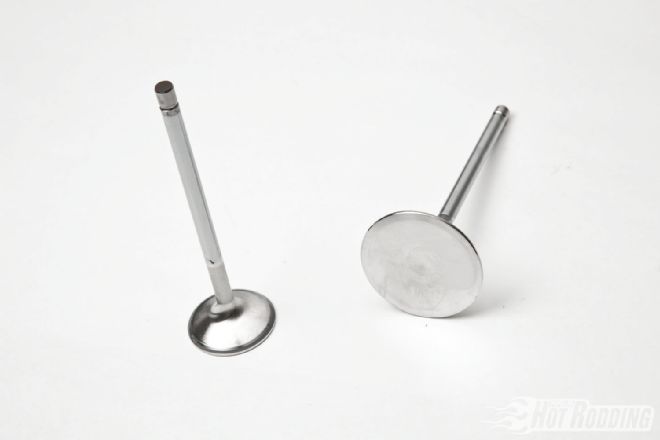 Although steel intake valves are light enough to run reliably in an engine that won’t turn more than 7,000 rpm, Mast went the extra mile by upgrading to 2.200-inch titanium pieces. Likewise, Inconel exhaust valves are more common in turbo motors that see ridiculously high exhaust gas temperature, but Mast opted for an extra margin of reliability by upgrading to 1.600-inch Inconel exhaust valves.
Although steel intake valves are light enough to run reliably in an engine that won’t turn more than 7,000 rpm, Mast went the extra mile by upgrading to 2.200-inch titanium pieces. Likewise, Inconel exhaust valves are more common in turbo motors that see ridiculously high exhaust gas temperature, but Mast opted for an extra margin of reliability by upgrading to 1.600-inch Inconel exhaust valves.
Perhaps the most obvious piece of the pump-gas compatibility puzzle in a forced-induction motor is the compression ratio. Generally, running less compression and more boost trumps running more compression and less boost. According to Mast, this explains why late-model EFI motors set at 10:1 compression or higher from the factory can only handle 8-9 psi of boost on pump gas, but dropping the compression ratio down to between 8.5:1 and 9.5:1 allows raising the boost to 14-16 psi on the same grade of fuel. "Some people run as high as 10.5:1 compression on pump gas, but the only real benefit is that you'll make a bit more torque at slightly lower boost. Beyond 9.7:1 compression, the horsepower benefits are negligible, but the margin for error in terms of tuning the ignition timing and air/fuel ratio becomes much smaller," explains Perry Kiritsy of Mast Motorsports.
Less obvious factors contributing to the pump-gas–friendly disposition of the Mast mill are the camshaft and combustion chamber design. "The cam in this motor is ground on a 117-degree lobe separation angle, which is 3 degrees wider than what we use on our naturally aspirated applications. Since there's a 20-degree duration split between the intake and exhaust lobes, there's still a fair amount of overlap, which in turn reduces the potential for detonation," Kiritsy says. Additionally, the efficient combustion chamber of the Mast cylinder head contributes to the pump gas cause as well. "LS motors have very efficient combustion chambers from the factory, which means that they require very little ignition timing advance. We have been able to improve upon the chamber efficiency even more with our Mast LS3 heads, and as a result, the supercharged 427 needs just 22 degrees of advance on the dyno."
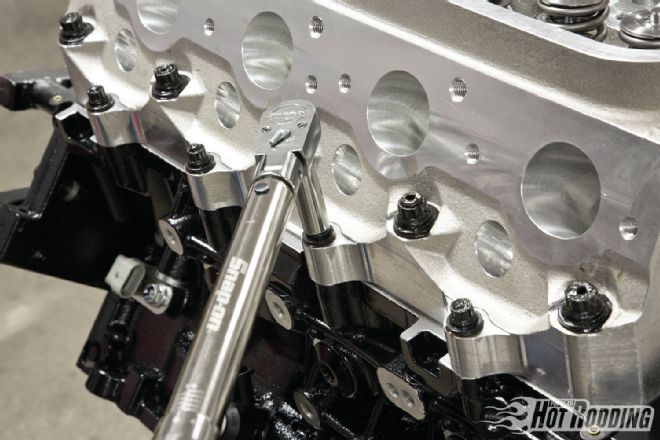 Both the RHS block and Mast LS3 heads have provisions for two additional head studs per cylinder. When combined with Cometic MLS head gaskets, the result is leak-free cylinder sealing without the need for O-rings or receiver grooves.
Both the RHS block and Mast LS3 heads have provisions for two additional head studs per cylinder. When combined with Cometic MLS head gaskets, the result is leak-free cylinder sealing without the need for O-rings or receiver grooves.
Screwed Over
Granted that a 427ci short-block and 387 cfm cylinder heads provide some serious horsepower potential, much of that potential would go to waste without a supercharger efficient enough to get the job done on pump gas. While centrifugal, Roots, and twin-screw superchargers all have their pros and cons, the need for immediate off-idle boost and compressor efficiency makes the 2.9L Whipple twin-screw unit the ideal piece of hardware for the Mast 427. Unlike a Roots blower that traps air between the internal lobes and the supercharger case, a twin-screw design compresses the air between the rotors themselves. The benefit of this approach is that less heat is added to the intake charge as it's being compressed. In fact, some twin-screw supercharger manufacturers claim an 80-degree reduction in inlet air temperature at 12 psi of boost compared to a Roots-style blower of similar capacity. While some may argue the legitimacy of those claims, a cooler intake charge equates to a lower potential for detonation, and there's no question that the twin-screw–equipped Mast 427 makes big-time power on pump gas.
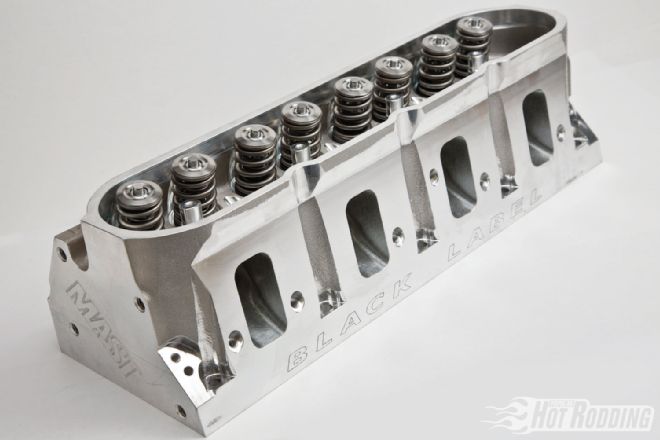 The Mast LS3 cylinder heads flow an impressive 387 cfm on the intake side and 252 cfm on the exhaust side. That’s right on par with many quality aftermarket big-block Chevy castings. Other features include a thick .750-inch deck for superior cylinder seal, dual valvesprings, titanium retainers, and CNC-machined ports and combustion chambers.
The Mast LS3 cylinder heads flow an impressive 387 cfm on the intake side and 252 cfm on the exhaust side. That’s right on par with many quality aftermarket big-block Chevy castings. Other features include a thick .750-inch deck for superior cylinder seal, dual valvesprings, titanium retainers, and CNC-machined ports and combustion chambers.
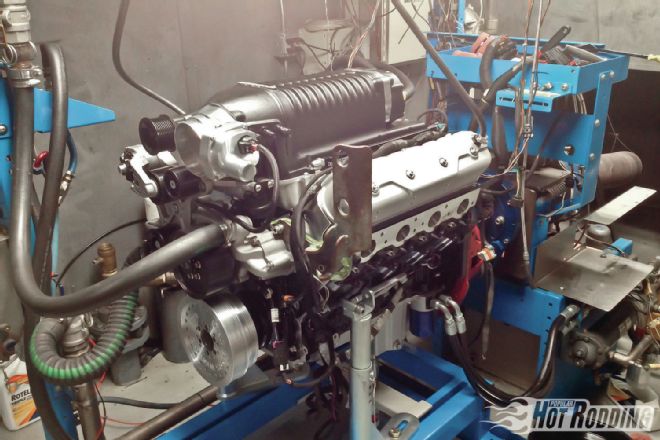 With the Mast M-120 stand-alone computer dialing in a 12.1:1 air/fuel ratio and 22 degrees of ignition advance, the supercharged 427 punished the SuperFlow dyno with 917 hp at 6,400 rpm and 817 lb-ft at 4,900 rpm. The motor exhaled through 2.000-inch dyno headers, and a steady stream of water from the dyno’s water supply fed the intercooler core.
With the Mast M-120 stand-alone computer dialing in a 12.1:1 air/fuel ratio and 22 degrees of ignition advance, the supercharged 427 punished the SuperFlow dyno with 917 hp at 6,400 rpm and 817 lb-ft at 4,900 rpm. The motor exhaled through 2.000-inch dyno headers, and a steady stream of water from the dyno’s water supply fed the intercooler core.
BY THE NUMBERS 427CI MAST MOTORSPORTS LS3 Bore: 4.125 inches Stroke: 4.000 inches Displacement: 427 ci Compression ratio: 9.45:1 Camshaft: Mast hydraulic roller Camshaft duration: 234/254 degrees at .050-inch tappet rise Valve lift: .648/.676 inch Rocker ratio: T&D 1.8:1 ratio Piston rings: Total Seal; .023, .025, .015 Piston: Mahle -25cc dish Block: RHS standard deck Crankshaft: Callies/Compstar forged steel Rods: Callies/Compstar 6.125-inch H-beam Cylinder head: Mast Motorsports LS3 Intake valve diameter: 2.200 inches Exhaust valve diameter: 1.600 inches Induction: Whipple 2.9L supercharger Throttle body: Nick Williams 102mm Engine management: Mast Motorsports M-120 EFI Header: Mast 2.000-inch primary Ignition: GM coil packs, NGK spark plugs Damper: Innovators West
ON THE DYNO 427CI MAST MOTORSPORTS LS3 RPM: TQ: HP: 3,100 743 439 3,200 742 452 3,300 744 468 3,400 750 485 3,500 758 505 3,600 765 525 3,700 773 545 3,800 779 564 3,900 785 583 4,000 792 603 4,100 800 625 4,200 805 644 4,300 808 662 4,400 809 678 4,500 810 695 4,600 811 710 4,700 811 726 4,800 814 744 4,900 817 762 5,000 815 776 5,100 812 788 5,200 812 804 5,300 814 801 5,400 813 836 5,500 810 848 5,600 805 859 5,700 801 869 5,800 795 878 5,900 786 883 6,000 779 890 6,100 774 899 6,200 768 907 6,300 761 913 6,400 755 917